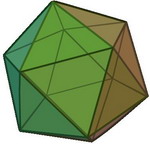Icosahedron
Pronunciation: /aɪˌkoʊ.səˈhid.rən/ Explain
|
An icosahedron is any 20-sided polyhedron. A regular icosahedron has congruent 20 sides, 12 vertices and 30 edges. Each side is an equilateral triangle. The Euler-Descarte formula for an icosahedron is 12 + 20 - 30 = 2. The word 'icosahedron' comes from 'icos', which is derived from the Greek word for twenty and 'hedron', which comes from the Indo-European word for seat. A geometric net is a 2-dimensional figure that can be folded into a 3-dimensional shape. Click for a geometric net you can fold into an icosahedron. |
References
- McAdams, David E.. All Math Words Dictionary, icosahedron. 2nd Classroom edition 20150108-4799968. pg 93. Life is a Story Problem LLC. January 8, 2015. Buy the book
More Information
- McAdams, David E.. Geometric Net of a Regular Icosahedron. lifeisastoryproblem.com. Life is a Story Problem LLC. 2/11/2010. http://www.lifeisastoryproblem.com/explore/net_icosahedron.pdf.
Cite this article as:
McAdams, David E. Icosahedron. 12/21/2018. All Math Words Encyclopedia. Life is a Story Problem LLC. https://www.allmathwords.org/en/i/icosahedron.html.Image Credits
- All images and manipulatives are by David McAdams unless otherwise stated. All images by David McAdams are Copyright © Life is a Story Problem LLC and are licensed under a Creative Commons Attribution-ShareAlike 4.0 International License.
- Regular Icosahedron: Cyp, https://en.wikipedia.org. This file is licensed under the Creative Commons Attribution-Share Alike 3.0 Unported license. https://en.wikipedia.org/wiki/File:Icosahedron.gif.
Revision History
12/21/2018: Reviewed and corrected IPA pronunication. (McAdams, David E.)8/6/2018: Removed broken links, updated license, implemented new markup, implemented new Geogebra protocol. (McAdams, David E.)
2/11/2010: Added "References". (McAdams, David E.)
8/9/2008: Added More Information, information about vertices and edges, and derivation of the word. (McAdams, David E.)
6/9/2008: Initial version. (McAdams, David E.)
- Navigation
- Home
- Contents
-
# A B C D E F G H I J K L M N O P Q R S T U V W X Y Z - Teacher Aids
- Classroom Demos
- How To
- LIASP
- LIASP Home
- Conditions of Use
- Privacy Policy
- Donate to LIASP
- Help build this site
- About LIASP
- Contact LIASP
All Math Words Encyclopedia is a service of
Life is a Story Problem LLC.
Copyright © 2018 Life is a Story Problem LLC. All rights reserved.
This work is licensed under a Creative Commons Attribution-ShareAlike 4.0 International License
